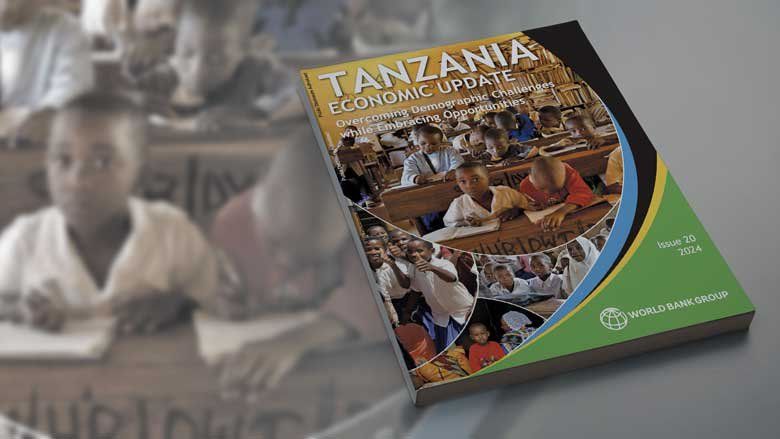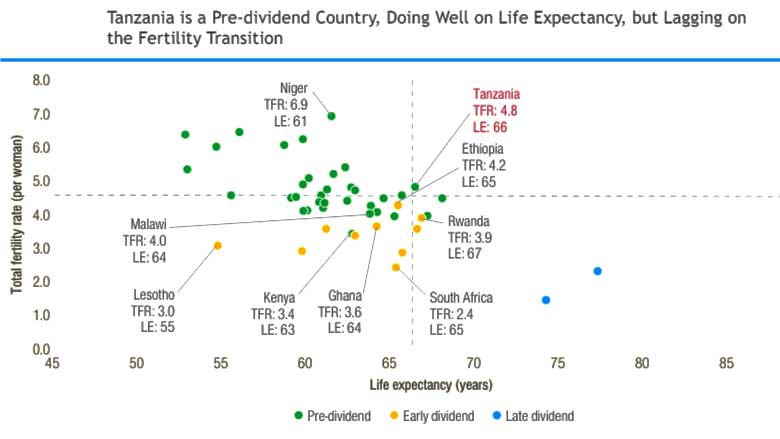
STORY HIGHLIGHTS
- While the fertility rate in Tanzania has been declining over the last several decades, the population growth rate remains high at three %, putting pressure on service delivery.
- Accelerating fertility decline can enable the nation to benefit from its youthful population and reap the benefits of a demographic dividend.
- The economy has been resilient, growing by 5.2% in 2023, compared to 4.6% in 2022, but growth continues to have minimal impact on poverty reduction in part because of high population growth.
Dar es Salaam, March 12, 2024—Infant and child mortality rates in Tanzania have significantly decreased over the past few decades, whereas fertility rates have only slightly decreased. Consequently, the population growth rate remains high, at three%. This high growth rate is expected to cause a surge in demand for essential services such as education and health, and employment opportunities, outstripping the economy's capacity to provide them.
For example, at the current fertility rates, projections show that the total school-age population will increase to 44.3 million by 2061 in a low-fertility scenario. On the other hand, under the high fertility scenario, this figure could rise to 65.5 million, representing an increase of nearly 50%. In terms of actual spending, if fertility remains high, the cost of public education will increase from 3.3% to 4.1% of the GDP by 2061. However, if fertility rates decrease, the cost of public education is expected to drop to 2.9%.
The just released 20th Tanzania Economic Update (TEU) shows that accelerating a fertility decline has the potential to enable the country to reap the benefits of a demographic dividend, which refers to how improved health and reduced fertility can drive economic growth. When a country experiences better health outcomes and fewer births, its age structure changes. This shift means more people are in the working-age bracket compared to those who are not working, which boosts economic growth and helps reduce poverty.
The TEU titled, Overcoming Demographic Challenges While Embracing Opportunities, shows that at the current population growth rate of 3%, the number of people will double every 23 years. However, accelerating the demographic transition, which leads to a higher share of working-age people in Tanzania, would lead to almost double per capita GDP growth by 2050 and potentially lift six million people out of poverty. This, in turn could yield further benefits such as improved institutional quality, thereby potentially lifting six million of its citizens out of poverty.
“Good policies are needed for Tanzania to reap the demographic dividend,” said Chiho Suzuki, World Bank Senior Health Specialist and co-author of the report. “Tanzania’s long-term economic prospects will be enhanced by changes in the age structure resulting in lower dependency ratios, an expanded labor force, and a boost in savings.”
The report authors propose an integrated approach towards accelerating the demographic dividend, emphasizing a mix of policies and programs. Their recommendations include:
- Accelerating ongoing programs to expand access to secondary education and strengthen completion rates for girls while not leaving boys behind. This includes emphasis on completing quality secondary education for girls.
- Scaling up access to high-quality, affordable family planning or reproductive health services while addressing social norms using innovative approaches, including community outreach strategies. This intervention should focus on the poor and vulnerable women and young girls.
- Improving child survival, continue to lower stunting rates and improve health outcomes, to give parents the confidence to have fewer children.
- Continuing focus on adolescent girls and promoting the economic empowerment of women and girls to support their reproductive health and strengthen health-seeking behaviors and investments in their children.
The latest Tanzania Economic Update also shows that the economy has remained strong despite multiple shocks, although progress on poverty reduction has been slow. The country’s fundamental challenge remains how to make growth more inclusive and generate more opportunities and better jobs for all Tanzanians.



